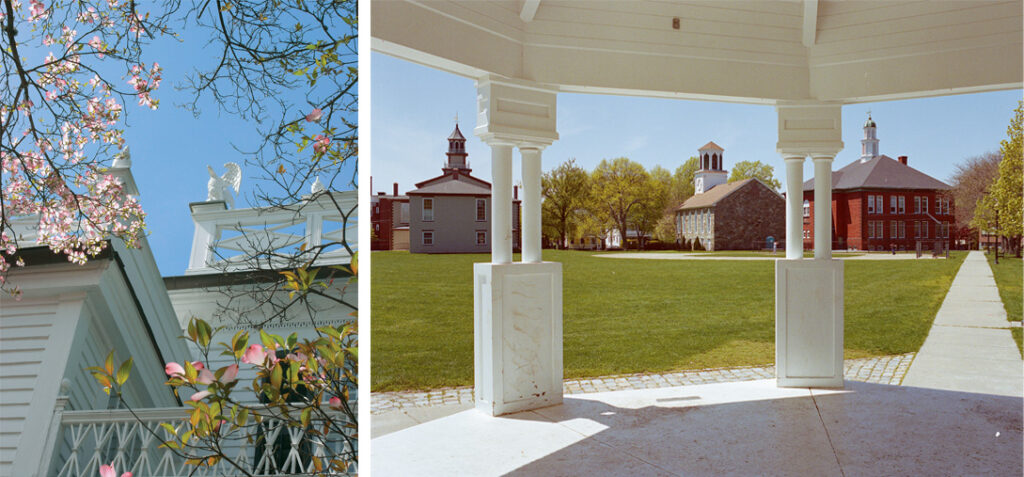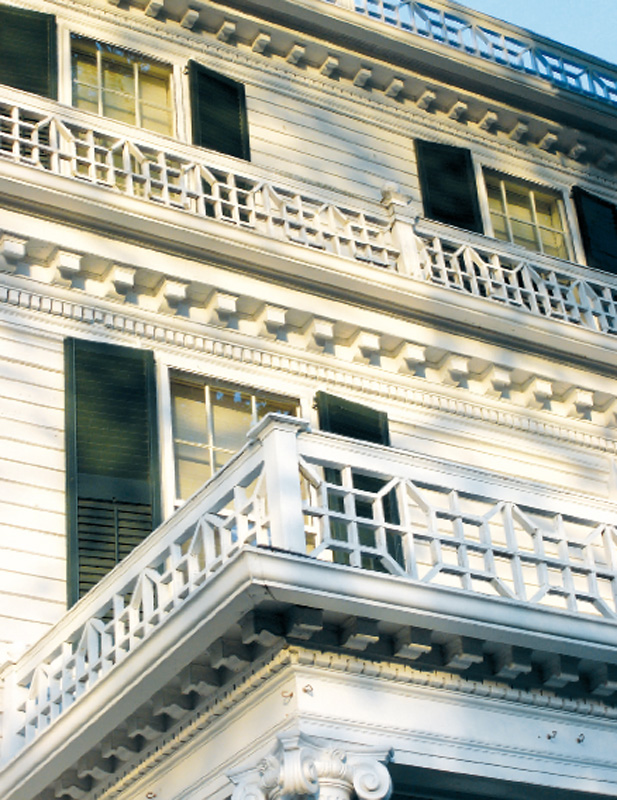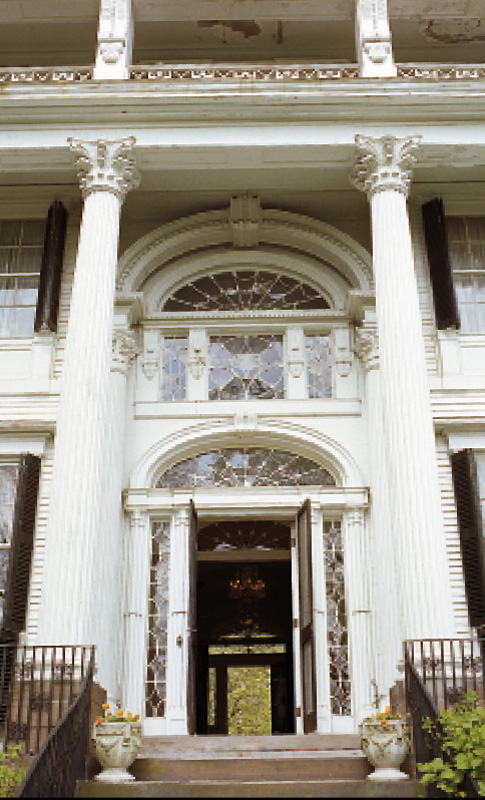from The Magazine ANTIQUES, Summer 2010 |

On a blustery March day in 1813, James DeWolf pored over the ledgers in his counting house in Bristol, Rhode Island. Startled by the roar of a cannon, he sprang to his feet. His mind flashed back to 1775, when the British had shelled Bristol and subsequently burned thirty buildings including his childhood home. Could the British have returned to wreak havoc on the village for its privateers that menaced British shipping? Then Captain DeWolf began slowly counting the blasts. At eighteen he smiled, for his ship the Yankee had eighteen guns, and he knew she was giving the town a salute. He opened his door and strode through the crowd of curious villagers working their way to Pump Lane Wharf.

His fellow merchant Nicholas Peck (1762–1847) greeted him there. They looked down Narragansett Bayand saw the hermaphrodite-rigged, 160-ton brigantine Yankee rounding Prudence Island. On its left sailed a larger brig, Shannon, and on its right a sleek and fast schooner, Thames. The sale of these two captured British prizes would swell DeWolf ’s coffers and those of the town. Tonight the Yankees’s crew would raise their glasses of rum at the Old Bay State to the sailors who had died in action, and would celebrate their victories and share of the prizes. The ship’s officers and Bristol merchants would toast DeWolf ’s pluck and prowess with champagne at his mansion called the Mount. (2)

Of the 515 privateers commissioned by James Madison in the War of 1812, DeWolf ’s Yankee exacted the greatest toll on British maritime trade. In three years of wartime service, it destroyed £1 million worth of British vessels and cargo and made a profit of $1million. (3) While DeWolf certainly benefited financially from the war, he had built his fortune on trade to the West Indies, Europe, and Africa. Before the conflict his family had owned twenty-three ships, seventeen sloops, twenty schooners, twenty-nine brigs, three snows, one bark, and a packet. (4) Their warehouses were chock-ablock with boxes of sugar, hogs heads of molasses, ingots of pig iron, bags of coffee, puncheons of rum, zeroons of indigo, ropes of onions, barrels of salt, pipes of Madeira, and stacks of ivory and dye woods.

Members of the family participated as seamen or investors in more than ninety slave voyages between 1769 and 1807. The historian Jay Coughtry wrote, “Without a doubt…[they] had the largest interest in the African slave trade of any American family before or after the Revolution; theirs was one of the few fortunes that truly rested on rum and slaves.” (5) Indeed, few merchants succeeded in this business fraught with high risk and the need for significant capital investment. As a group, the 426 Rhode Island slaver captains identified by Coughtry averaged only 2.2 African voyages—and their reluctance to continue was based primarily on fear of death and economic loss, not (or at best secondarily), on moral qualms. (6)

While the DeWolfs were the protagonists of the drama of eighteenth- and nineteenth century Bristol, their stage was the world where their ships roamed and their products were traded. The cast also boasted other well-developed characters of great appeal. Babbits, Bordens, Bosworths, Bradfords, Churchs, Colts, Dimonds, Pecks, Talbots, Ushers, and Wardwells all played opposite the DeWolfs as in-laws, business partners, and state legislators. Many of them were related to the Boston merchants who had purchased the land from the Plymouth Colony for £1,100 and founded Bristol in 1680: Nathaniel Byfield (1653– 1733), John Walley (1644–1712), Stephen Burton (d. 1693), and Nathaniel Oliver (1651/52–1704). Settlers cleared the forest for farms, roads, house lots, and a common for grazing cows, sheep, and horses. They built houses that rose a full two stories in the front, with roofs sloping to low woodsheds at the back. (7) These rude dwellings, the town green, and the Congregational church (founded simultaneously with Bristol in 1680) defined the townscape, just as the farming of corn, barley, tobacco, and onions defined its economy.

Of the four first proprietors of Bristol, Byfield distinguished himself most in business and civic service. He commissioned a sloop named the Bristol Merchant from Deacon Woodbury, who had established Bristol’s first shipyard at the head of the harbor. The supplier of mahogany for Byfield’s sloop, Henry Mackintosh (d. 1725), came to Bristol from Dutch Guiana to collect on his bill, and in the course of settling his account married Byfield’s daughter Elizabeth and joined him in business. In 1686 Byfield shipped Narragansett pacers and red onions to the sugar plantations of Dutch Guiana. (8) He also served five times as a delegate from Bristol to the Massachusetts General Court and received commissions as judge of the vice-admiralty under three different sovereigns. Byfield originally settled at Mount Hope Farm, but he sold the property to Mackintosh and moved to nearby Poppasquash Peninsula about 1714. In 1745 Isaac Royall Jr., who had married Mackintosh’s daughter in 1738, acquired the property and built a two-and-ahalf- story gambrel-roofed house (Fig. 3). The wealthy son of Isaac Royall Sr. (1672–1739), a slave-owning sugar planter from Antigua, Royall Jr., who was immortalized with his family in the famous painting by John Feke in Figure 4, multiplied his income through the distilling of rum and the slave trade. A British loyalist, he left the United States in 1775, and the colonial governments of Massachusetts and Rhode Island subsequently confiscated his properties.

Mount Hope was acquired in 1783 by William Bradford, the great-great grandson of the eponymous early Plymouth Colony governor. (9) A physician, lawyer, and owner of a rum distillery in Bristol, the younger William Bradford served as deputy governor of Rhode Island (1775–1778) and later as a United States senator (1793– 1797). (10) James DeWolf, who married his younger daughter, Ann Bowman Bradford (1770–1838), in 1790, followed a comparable course of civic service—as speaker of the Rhode Island House (1819–1821) and as a United States senator (1821–1825).

When the likes of the Bradfords and DeWolfs desired mansions that reflected their position and prosperity, they retained the architect Russell Warren, sometimes called the “Samuel McIntire of Bristol.” (11) These men of the sea demanded houses as soundly built as their brigantines and schooners, and they appreciated decorative elements as carefully crafted as the Federal style furniture in their interiors. Warren, who was born in nearby Tiverton, moved to Bristol in 1800, drawn by its vibrant economy. Trained as a housewright by his father Gamaliel (1744– 1807), he quickly gained a reputation as a gifted architect. In 1808 he built a house decorated with superb architectural woodwork for James DeWolf ’s nephew John Howe, who practiced law and served as a state legislator for several terms. Ship captain Benjamin King Churchill later acquired the house (Fig. 7).

Bristol’s seaborne commerce declined precipitously after 1812, dropping by more than 50 percent in fifteen years from a high in 1810 of ninety-six vessels arriving from foreign ports, in addition to coastal vessels. (12) Several factors contributed to the decline, including Bristol’s shallow harbor, which precluded deep-draft ships; the centralization of shipping at major ports; stronger laws and enforcement against the slave trade; the conversion of merchant vessels to whalers; and the transportation of prospectors to California aboard Bristol ships that were then simply scuttled in San Francisco Bay. (13)

Some DeWolf family members tried to sustain their maritime business, but failed. George DeWolf (see Fig. 11), a son of James’s brother Charles (1745–1820), for example, enjoyed great initial success in the West Indies trade and commissioned Warren in 1810 to build Linden Place, the grandest of the four mansions he ultimately designed for the family (Figs. 12, 12a). But in June 1825 the sugar crop on DeWolf ’s Cuban plantations failed, and banks began calling in loans. He buried his year-old daughter Julia Brown DeWolf on December 6, and fled to Cuba, before word of his bankruptcy reached the ears of his Bristol neighbors, who suffered catastrophic losses through their investments with him. (14)

Many of George’s relatives, however, retained their fortunes, in part because, before the War of 1812, the DeWolfs had begun diversifying, withdrawing risk capital from marine ventures and investing in the fledgling cotton industry. They entered cotton manufacturing with the benefit of well-established relationships with southern growers that stemmed from Bristol merchants having sent produce and livestock south on DeWolf sloops for more than a century. In addition, in 1804 James DeWolf ’s nephew Henry (1786–1857) had moved to Charleston and joined Charles Christian in managing the DeWolfs’ slave importations. (15) In his role as a factor Henry met frequently with cotton plantation owners, and his daughter Anne (1815–1908) married Nathaniel Russell Middleton (1810–1890), thus joining the DeWolfs to one of Charleston’s most distinguished families.

In 1810 Charles and James DeWolf helped capitalize two water-powered cotton mills, the Arkwright Company in Coventry, Rhode Island, and the Bristol Cotton Manufacturing Company in Dighton, Massachusetts. (16) Later, steam-powered textile mills were established in Bristol by other “lords of the loom,” including John Norris (1791–1866) of the Pokanoket Steam Mill and Jacob Babbitt (1809–1862) of the Bristol Steam Mill.

Other manufacturing began to take hold as well. Cornelius Royal Dimond (1821–1901) and Samuel Norris (1827–1902) jointly owned the Bristol Sugar Refinery, established in 1849, an offspring of the early sugar trade focused on molasses, rum, and slaves. And Norris later entered into the manufacture and sales of small arms, first on his own and later with E. Remington and Sons. (17) Dimond was the son of Francis M. Dimond, formerly the United States consul to Mexico and governor of Rhode Island, who in the 1840s had bought the house William Bradford built on Hope Street in 1792. Francis Dimond passed the property to his daughter Isabella and her husband, Samuel Norris, who retained Russell Warren to remodel it. Warren added a third story with beautifully crafted balustrades (see Figs. 8, 8a).

Rubber manufacturing in Bristol began with the arrival of Augustus O. Bourn in 1864. After attending Brown University, he had joined his father in the Providence firm of Bourn, Brown and Chaffee, which manufactured India rubber shoes based on patents held by Edwin M. Chaffee (1806–1872), who had aided Charles Goodyear (1800–1860) in his discovery of vulcanization in 1839. (18) Bourn organized the successor firm, the National Rubber Company, and in 1864 built a large plant in Bristol. He served as treasurer and manager of National Rubber from 1865 until 1887. To celebrate his good fortune, Bourn commissioned James Renwick Jr. to design a Gothic revival stone house called Seven Oaks, which was completed in 1873 (Fig. 15). Though best known for the Smithsonian Institution Building (1855) in Washington and Saint Patrick’s Cathedral (1858) in New York, Renwick also designed mansions for wealthy patrons such as Bourn. Perhaps due to the demands of his political life as a state senator (1876–1883) and governor (1883–1885), Bourn’s rubber interests failed. In 1887 his colleague in the state legislature Samuel Pomeroy Colt (1852–1921) was appointed receiver for the bankrupt company. Bourn’s only consolation was being appointed United States consul general to Italy by Benjamin Harrison from 1889 to 1893. He never recovered financially after returning to Bristol, although he began manufacturing again in Providence as the Bourn Rubber Company in 1902. (19) In her final years, his impoverished daughter Bessie was forced to sell Seven Oaks and to work in the Bristol rubber factory once owned by her father.

Colt, Bourn’s successor at the National Rubber Company, was the nephew of Samuel Colt (1814–1862), the manufacturer of repeating revolvers. He had moved to Bristol as a youth in 1865 with his mother, Theodora Goujand DeWolf Colt (1824– 1901), George DeWolf ’s daughter, who had bought back her childhood home, Linden Place. After serving four one-year terms as state attorney general, Colt founded the Industrial Trust Company in 1886, a banking corporation that grew into the Fleet/Norstar Corporation. (20) Then, as the new owner of National Rubber, he reorganized it into the National India Rubber Company, which manufactured boots and shoes. In 1892 he and nine other industry leaders consolidated their interests to form the United States Rubber Company, a conglomerate that became the world’s largest manufacturer of rubber goods. Its suppliers linked Bristol once again to slavery, if only indirectly.

During Colt’s tenure as a director and then president (1901–1918), United States Rubber obtained most of its crude rubber from Hevea brasiliensis trees in the Amazonian jungle of Brazil. (21) The abuse of workers who extracted and processed the latex sap is extensively documented. Historian Jonathan D. Hill recorded that “accounts of Rubber Boom terror from regions as widely dispersed as the Madre de Dios River in southern Peru to the upper Rio Negro and Orinoco rivers in southern Venezuela offer a uniformly horrifying scenario of torture, enforced debt, and genocide.” (22)
Over the past three centuries, rubber manufacturing, textile production, privateering, rum distilling, shipping, and farming have shaped Bristol’s life and landscape. In the eighteenth century the town’s nexus of activity shifted west from the cultivated lands and town green to the east—to the wharves on Thames Street and to the shops and elegant residences of merchants and sea captains on Hope Street. Unlike most New England towns where church steeples prevailed, a forest of masts dominated Bristol’s skyline. Twenty wharves stretched like fingers toward the ports Bristol served: Havana, Bilbao, Charleston, Canton, Petropavlovsk, Cadiz, Montevideo, Liverpool, and Antwerp. As maritime trade declined in the nineteenth century, the wharves decayed or were torn down and were replaced by steam-powered textile mills. Today some of these massive structures have been converted into shops, offices, and condominiums, as tourism has become a major source of revenue.
Yet, despite all the changes to its townscape andeconomy over the centuries, Bristol remains as historian William Jordy observed, “among the queen cities of colonial and nineteenth-century New England.” (23)
The author and photographer want to thank the owners of buildings to which we were given access.
1 William H. Jordy, Buildings of Rhode Island, ed. Ronald J. Onorato and William McKenzie Woodward (Oxford University Press, Oxford, 2004), p. 466.
2 My account is derived from those given in Wilfred Harold Munro, The History of Bristol, Rhode Island: The Story of the Mount Hope Lands (Providence, 1880), p. 306; M. A. DeWolf Howe, Bristol Rhode Island: A Town Biography (Harvard University Press, Cambridge,1930), p. 91; and George Locke Howe, Mount Hope, A New England Chronicle (Viking Press, New York, 1959), p. 177.
3 Howe, Mount Hope, p. 169, and Munro, History of Bristol, p. 310.
4 Howe, Mount Hope, p. 168.
5 Jay Coughtry, The Notorious Triangle: Rhode Island andthe African Slave Trade 1700–1807 (Temple University Press, Philadelphia,1981), p. 48.
6 Ibid. Bristol Judge John Saffin (1632–1710) voiced what many believed, “It is no evil to bring them [Africans] out of their heathenish country [to] where they may have knowledge of the True God, be converted and eternally saved”; quoted in William D. Piersen, Black Yankees: The Development of an Afro-American Subculture in Eighteenth-Century New England (University of Massachusetts Press,Amherst, 1988), p. 52. This tolerance of slavery is perhaps less shocking when one realizes that whites and American Indians were also held in enforced servitude; see Don Jordan and Michael Walsh, White Cargo: The Forgotten History of Britain’s White Slaves in America (New York University Press, New York, 2007), p. 14; and Jill Lepore, The Name of War: King Philip’s War and the Origins of American Identity (Knopf, New York, 1998), pp. 150–170.
7 Howe, Mount Hope, pp. 65–66.
8 Ibid., p.69.
9 Charles Warren, History of the Harvard Law School and of Early Legal Conditions in America (Lewis Publishing Company, New York,1908), pp. 278–279.
10 Thomas W. Bicknell, The History of the State of Rhode Island and Providence Plantations (American Historical Society, New York, 1920), pp. 1142–1143.
11 Joy Wheeler Dow, An Architectural Monograph on the Bristol Renaissance, White Pine Series of Architectural Monographs, vol. 3, no. 5 (October 1917), p. 3.
12 Charles O. F.Thompson, Sketches of Old Bristol (Roger Williams Press, Providence, 1942), p. 90.
13 Munro, History of Bristol, pp. 370–371.
14 Howe, MountHope, p. 230.
15 Ibid., p. 124.
16 Massachusetts Historical Commission, Reconnaissance Survey Town Report Dighton (Boston, 1981), p. 8.
17 New England Families, Genealogical and Memorial, ed. William Richard Cutler, 3rd ser., vol. 4 (Lewis Historical Publishing Company, New York, 1915), p. 2092.
18 The American Cyclopædia: A Popular Dictionary of General Knowledge, ed. George Ripley and Charles A. Dana (New York, 1873–1876), vol. 3, p. 737.
19 “Augustus O. Bourn,” The History of the State of Rhode Island and Providence Plantations: Biographical (American Historical Society, New York, 1920), pp. 74–75.
20 Historical Notes, Colt Family Papers, 1793–1961, Special Collections, University of Rhode Island Libraries, Kingston.
21 Glenn D. Babcock, Historyof the United States Rubber Company: A Case Study in Corporation Management (Bureau of Business Research, Indiana University, Bloomington, 1966), p. 82.
22 Jonathan D. Hill as quoted in The Cambridge History of the Native Peoples of the Americas, vol. 3, part 2, ed. Frank Salomon and Stuart B. Schwartz (Cambridge University Press, Cambridge, 1999), p. 752.
23 Jordy, Buildings of Rhode Island, p. 464.
